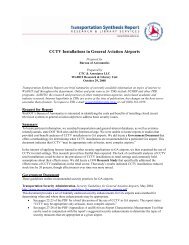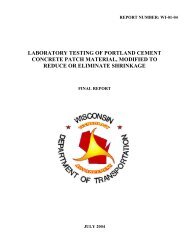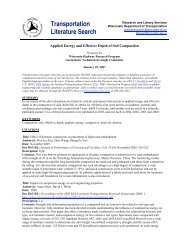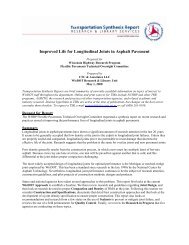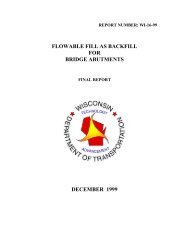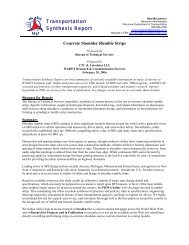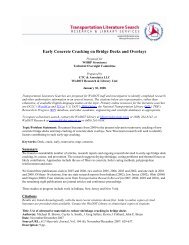Mow Strip Design and Practices - WisDOT Research
Mow Strip Design and Practices - WisDOT Research
Mow Strip Design and Practices - WisDOT Research
You also want an ePaper? Increase the reach of your titles
YUMPU automatically turns print PDFs into web optimized ePapers that Google loves.
A 2004 letting schedule for Texas’ Beaumont District includes line items for the installation of a cable barrier <strong>and</strong>mow strip in two counties (see http://www.txdot.state.tx.us/insdtdot/orgchart/cmd/cserve/let/2004/letbmt.htm).TxDOT <strong>Research</strong>The Texas Transportation Institute (part of Texas A&M University) conducts a significant amount of roadside safetydevice research. Two recent reports for TxDOT by TTI Roadside Safety Program investigator Roger Bligh addressthe topics of mow strips <strong>and</strong> cable barriers, although not as they relate specifically to each other.• The 2006 report “Median Barrier Guidelines for Texas” makes a minor reference to mow strips, indicating thatfurther research is needed on “whether a concrete or other type of mow strip [is] cost-effective.” Seehttp://tti.tamu.edu/documents/0-4254-1.pdf (page 85 of the PDF).• Two reports from 2004, “Dynamic Response of Guardrail Systems Encased in Pavement <strong>Mow</strong> <strong>Strip</strong>s”(http://tti.tamu.edu/documents/0-4162-2.pdf) <strong>and</strong> “Evaluation of Roadside Safety Devices Using Finite ElementAnalysis” (http://tti.tamu.edu/documents/0-1816-1.pdf) detail many mechanical <strong>and</strong> technical aspects of mowstrip installation <strong>and</strong> response, but specifically for guardrails rather than cable barriers.We contacted Roger Bligh to determine what additional research is planned or in process related to mow strips forcable barriers. He told us that since cable barriers are a “weak post system,” he believes there is not a greatconsequence in crash response for embedded posts by the addition of a mow strip. He said the decision to use mowstrips also involves operations decisions (limiting worker exposure by reducing h<strong>and</strong>-mowing) <strong>and</strong> life cycle costs(including mow strip installation costs, post replacement costs with a mow strip in place, <strong>and</strong> savings from reducedmowing). He was not aware of a formal cost analysis on this topic.Contact: Roger Bligh, TTI Roadside Safety Program, (979) 845-4377, rbligh@tamu.edu.FloridaRoadway <strong>Design</strong> Bulletin, “High Tension Cable Barriers,” 2007-08http://www.dot.state.fl.us/rddesign/updates/files/RDB07-08.pdf (page 5 of the PDF)In this bulletin, Florida DOT provides limited specifications for mow strips for high-tension cable barriers: “Unlessdetermined otherwise by the District, place a 3-foot-wide 2-inch-thick miscellaneous asphalt mow strip under thecable barrier, similar to that used for the guardrail. The mow strip should be centered along the cable barrieralignment. Since no st<strong>and</strong>ard index drawings have been issued at this time, the mow strip must be detailed in theplans.”FDOT’s general requirements for mow strips, not specifically related to cable barriers, call for “miscellaneousasphalt”—any approved asphalt mix except open graded friction course—at 3 feet wide by 2 inches deep.Specifications for miscellaneous asphalt are detailed athttp://www.dot.state.fl.us/specificationsoffice/2007BK/339.pdf.IllinoisSpecial Provision for High Tension Cable Median Barrier, September 2006http://www.dot.il.gov/desenv/pdf/80169.pdf (page 3 of the PDF)Illinois provides this construction requirement: “When the barrier is to be placed within paved shoulders or mowstrips, the paved area(s) shall be constructed first <strong>and</strong> the concrete foundations placed in cored or formed holes.”Nebraska<strong>Design</strong> St<strong>and</strong>ards Engineer Phil TenHulzen from the Nebraska Department of Roads provided the state’srequirements for mow strip installations used with cable median barriers: 3 feet wide by 5 inches deep, usuallyconstructed from asphalt at $27–$31 per square yard. Detailed material specifications are the same as those used forguard rails, listed in Appendix C.Contact: Phil TenHulzen, (402) 479-3951, ptenhulz@dor.state.ne.us.IndianaIndiana DOT <strong>Design</strong> Policy Engineer Richard VanCleave told us that although INDOT does not require or providespecifications for a mow strip under cable barriers, it advises designers that using some form of “vegetation controlstrip” would be appropriate to avoid unintended lawnmower contact with the barriers. INDOT suggests that4



